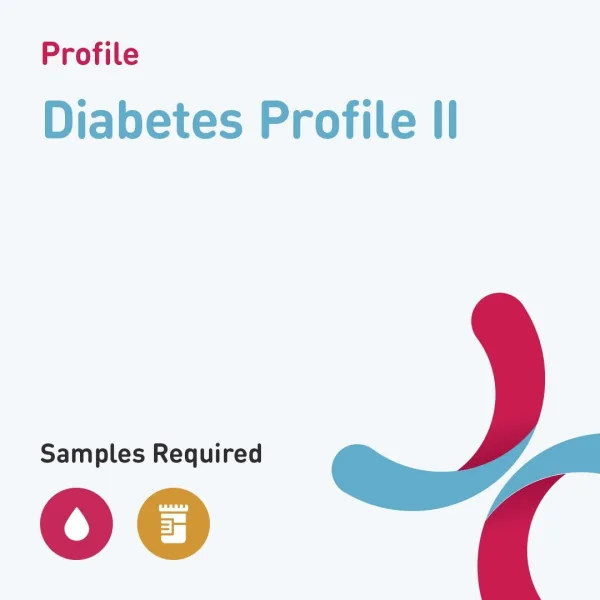Medical Diagnosis Exams
Diabetes Profile II
£92.00
Diabetes mellitus is a condition in which the level of glucose (sugar) in blood becomes too high because the body cannot use it properly. This results either from an inability to produce insulin or because the body has become resistant to the insulin produced. About 2.8 million people in the United Kingdom (4.45% of the population) are known to have diabetes and a further ¾ million may have the condition and not know it.
Insulin is a hormone, produced by the pancreas, which controls the movement of glucose into most of the body’s cells and maintains blood glucose levels within a narrow concentration range. Most tissues in the body rely on glucose for energy production, and all but a few are entirely reliant on insulin to deliver this essential fuel. Diabetes disrupts the normal balance between insulin and glucose.
Diabetes types
There are two types of diabetes: Type 1 (which used to be called insulin dependent diabetes or juvenile onset diabetes) and Type 2 (which used to be known as non-insulin dependent diabetes or adult onset diabetes). In addition, Gestational Diabetes is a term used to describe diabetes which is recognised for the first time during pregnancy. Pancreatic disease or damage can also cause diabetes if the insulin producing beta cells are destroyed.
Symptoms of impending hypoglycaemia:
Temporary hypoglycaemia in the diabetic patient may be caused by the accidental injection of too much insulin, not eating enough or waiting too long to eat, exercising strenuously, or by the swings in glucose levels seen in patients with diabetes which is difficult to control (often referred to as ‘brittle diabetes’). Hypoglycaemia needs to be treated because, if severe, it can rapidly progress to unconsciousness. True hypoglycaemia occurs when the blood sugar is below 2.5 mmol/L, though symptoms may develop earlier, especially if the blood sugar falls rapidly, and include:
• Sensation of hunger
• Headache
• Anxiety
• Sweating
• Confusion
• Trembling
• Weakness
• Double vision
• Convulsions (severe)
While there is no way to prevent Type 1 diabetes, the risk of having Type 2 diabetes can be greatly decreased by losing excess weight, exercising and by eating a healthy diet with limited fat intake. By identifying pre-diabetic conditions and making the necessary lifestyle changes to lower glucose levels to normal levels you may be able to prevent Type 2 diabetes or delay its onset by several years. Normalising blood glucose can also minimise or prevent vascular and kidney damage.
Ongoing treatment involves daily glucose monitoring and control, eating a healthy planned diet, and exercising regularly.
Samples required: 2
Results in: 4 hours
Exams included:
- Urine: Protein Total
- Glucose
- Glycated Haemoglobin (HbA1c)
- Urea
- Cholesterol Total
- High-Density Lipoprotein (HDL Cholesterol)
- LDL - Cholesterol
- Triglycerides
- CHOL RISK FACTOR
- [PARAM]Urine Examination!~!Amorphous cryst
There is an additional £15 phlebotomy fee for every donation.




